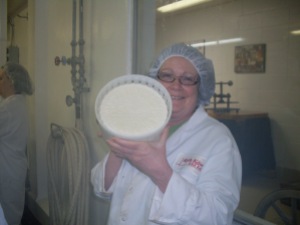Our final day in Wisconsin began early, very early. After a wonderful dinner the night before hosted by Roth Kase, we boarded the bus at 430am and headed to the Roth Kase where we would spend the day making Grand Cru Gruyere and Grand Queso cheeses.
Roth Kase makes a variety of specialty cheeses which Spaulding Gray reviewed earlier. The Plant Manager and their Sales Rep began the morning by giving us a quick overview of what we might expect of the day and the “nickel” tour of the plant.
After that we were divided into three groups and sent off to learn about cheesemaking and participate in making Gruyere and Queso cheeses. The cheeses we made were purchased by our parent company and after they have aged six months, they will be shipped to the stores with cheese kiosks and we will sell these cheeses during the Thanksgiving and Christmas holidays.
Our group began at the copper vats where the Gruyere must be made. When Roth Kase decided it wanted to become the first American Cheese Company making cheese, they went to the State of Wisconsin and were told they could only use stainless steel. There is a chemical reaction that occurs between the cultures and the copper that gives Gruyere some of its wonderful flavor nuances. The company was dedicated to this plan and paid to send an inspector to Switzerland to see how Gruyere is made. The State reversed its decision and approved both the copper vats and the use of red spruce planks for the aging process.
I added the starter to the milk that had already been heated to the desired temperature. After thirty minutes we added the rennet and again waited thirty minutes. At that point, we cut the cheese into curds and then it was pumped into the table where the curds were separated from the whey and the cheese was placed in the hoops to shape the wheels.
We were involved in flipping the wheels throughout the day to remove more moisture and to help shape the cheese. The Queso we made (about 350 wheels) was flipped six times before we sent it off to the brine.

We also smeared Gruyere which adds flavor and smell to the cheese. The Queso cheese, we rubbed with spices to give it more of an amber color and then we painted it with a food-quality finish to make it shiny.
We watched while wheels of cheese were placed in the brine. At Roth Kase, the wheels are left on racks which are completely submerged in the brine, eliminating one step of human turning of the wheels.
The entire process took six hours and was quite physically challenging. Flipping and transferring twenty-pound wheels of cheese is not easy. Especially when there are almost a thousand wheels involved.
But after a morning of hard work in the cheese mines we were treated to a lunch that started with a shot of Kirshwasser, a cherry brandy that is not sweet, but quite fiery. It is a tradition in Switzerland to serve Kirshwasser at the beginning of a meal to welcome your guests. It is also professed to aid with digestion. A fun piece of trivia. In Switzerland the farmers are allowed to make a certain amount at home to be used for “medicinal purposes” in treating their dairy cattle.
After the toast, we were treated a plate of Roth Kase cheeses including Grand Cru, Grand Queso, Rofumo, Fontina and Buttermilk Blue. The main course was a fondue lunch made with Fontina and Gruyere cheese. It was served with a locally-grown Riesling wine.
It was a wonderful day that ended with a tee shirt professing “I survived cheese making 101 at Roth Kase” and a gift bag with more goodies for us cheesemongers.
A special thank you to Roth Kase for giving me an added appreciation of how cheese is made. This day will always be a special memory for me.
Then it was back on the bus and a return to the real world, which for me included cancelled and delayed flights; spending too many hours in the Chicago airport and being up more than twenty hours straight…I’ve still got it…except I slept till 10am today and then took an afternoon nap…but I’ve still got it… Follow me on:

Good old O’Hare! It maintains it reputation and never has a satisfied customer!
Some things never change…it must be run by the rat ass bastard government folks…
Marcella,
Congrats on surviving the Cheesemaking 101.
Now it is back to chasing down the RAB’s.
John
…and chase them is a lot of the fun…better to catch and surpass them…
After reading all of the post – I don’t understand where the flavor is added l- i.e what makes Gruyere Gruyere, etc.? Also what does the rennet do?
The “flavor” comes from the starter and the rennet components. It also comes from the chemical reaction between the milk and the copper which is why Gruyere must be made in copper vats. Also the smearing of the rind affects the taste as well.
Enjoyed your travels to the midwest but glad you are back on Hawthorne Blvd again. Need to try some new cheeses.
It’s always good to go away…it’s always good to come home…
I also made cheese at Roth Kase last October. Looks like you had a great time. It was such a memorable experience! The trip gives you an even higher appreciation for thier artisinal cheeses. Bob was a fun cheesemaker to show us the ins and outs of the business too! It was a great educational experience, as I am also a cheesemonger, in MN.
Alicia, it is one of my best memories in the cheese world. Thanks for stopping by.
Same here! I love the site.